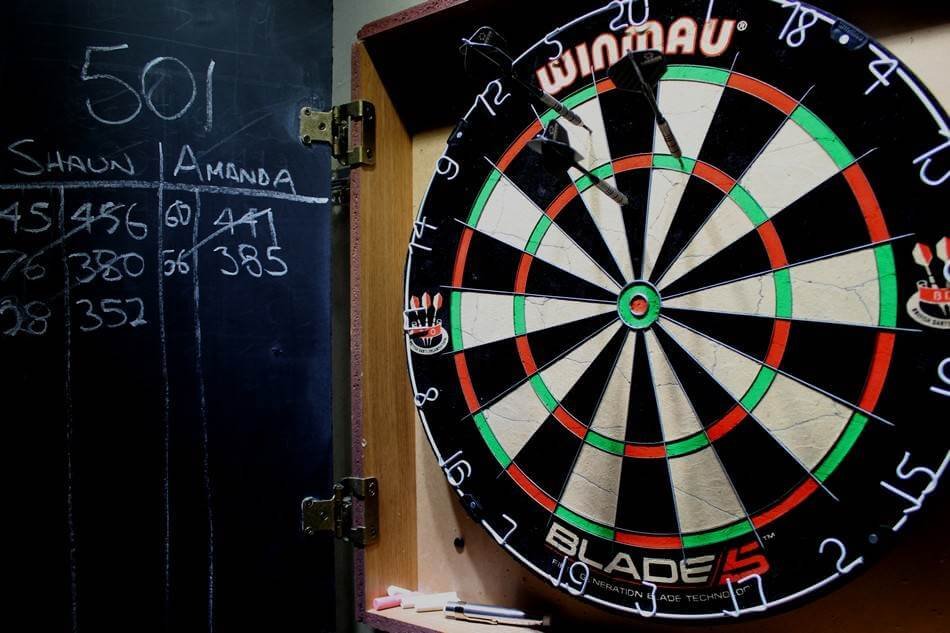While darts basics are easy to pick up, the finer details of the darts rules and regulations can often be overlooked, especially by newcomers. Knowing these rules inside and out is essential not only for fair play but also for improving as a player.
This article outlines the 10 most important rules every darts player should know, whether you’re just starting or looking to refine your understanding.
1. The Standard Starting Score: 501
In most professional and amateur darts matches, players begin with a score of 501. The aim of the game is to reduce this score to exactly zero before your opponent. The rule is straightforward, but it comes with a twist that adds strategy to the game: players must finish on a double.
- Why 501?: 501 is used because it strikes a balance between being challenging yet achievable in a reasonable number of turns. It allows for a wide range of strategic decisions during the game.
- Finishing on a double: To win, players must reach exactly zero with their final dart landing on a double. This rule often makes for dramatic finishes, as players may have to adjust their strategy based on their remaining score.
2. The Throwing Distance and the Oche
The distance from the throwing line (commonly known as the oche) to the dartboard is standardized in competitive play. Players must stand behind the oche when throwing their darts.
- Distance: The standard distance from the oche to the dartboard is 7 feet 9 1/4 inches (2.37 meters). This ensures consistency in the sport, regardless of where the game is played.
- Oche rules: Players must ensure that no part of their foot crosses the oche during a throw. Crossing the line, even slightly, results in a foul throw, and the dart may not count.

3. The Dartboard Setup
Proper dartboard setup is crucial for a fair and consistent game. The dartboard itself must be hung in accordance with specific guidelines to maintain the integrity of the game.
- Height: The dartboard should be hung so that the bullseye is exactly 5 feet 8 inches (1.73 meters) from the ground. This height is based on the average eye-level of players.
- Dartboard layout: The standard dartboard consists of 20 numbered sections, with scoring values ranging from 1 to 20. The bullseye is worth 50 points, while the outer bullseye ring is worth 25 points.
4. The Three-Dart Rule
Each player is allowed to throw three darts per turn. After the third dart, the player’s turn is over, and it’s their opponent’s turn to throw. This simple rule ensures that each player gets an equal opportunity to score points in each round.
- Scoring: The sum of the points from the three darts is subtracted from the player’s current score.
- Invalid throws: If a dart falls out of the board or bounces off, it doesn’t count. Players must live with the result of each throw, whether good or bad.
5. Doubling In and Doubling Out
While doubling out (finishing on a double) is common knowledge in darts, some formats require players to “double in” to start their score.
- Double in: In games like Double-In, players must hit a double to start their score. Any dart that lands outside a double before hitting a valid scoring double doesn’t count.
- Double out: As mentioned earlier, players must hit a double to finish the game. For example, if a player has 40 points left, they must hit a double 20 to win the game.
This adds an additional layer of strategy and precision to darts, forcing players to focus even more on their throwing accuracy.
6. Bust Rule
The bust rule is a crucial concept that can dramatically change the course of a game. If a player throws more points than they need to reach zero, they “bust” and their score reverts to what it was at the start of their turn.
- How it works: For example, if a player has 20 points left and throws a 12 followed by a 9, they will have “busted” since the total score would be more than 20. The player’s score goes back to 20, and they must try again in the next turn.
- Strategy: Players need to carefully plan their throws when their score gets low, especially in situations where they need to hit a precise double to finish the game.
7. The Marker and Scorer
In official matches, a marker and a scorer play an important role in ensuring the game runs smoothly and fairly. The marker stands next to the board and helps verify the score, while the scorer records the points after each turn.
- Neutrality: The marker and scorer must remain neutral and impartial, helping both players by accurately recording points.
- No coaching: The marker is not allowed to give advice or help a player with calculations. Players must do their own mental math to decide their next throw.
8. Game Variations: 301, 701, and Cricket
While 501 is the most common darts game, there are various other formats, each with its own unique rules and strategies.
- 301: This is a shortened version of 501, where players start at 301 points instead of 501. Like 501, the game requires a double out to finish. It’s a quicker version often played in casual settings.
- 701: This version extends the game by starting each player at 701 points, typically played in longer, more strategic matches, especially in team play.
- Cricket: A popular variation where the goal is to “close” numbers on the dartboard (20 through 15 and the bullseye) by hitting them three times. Scoring in cricket is based on accumulating points after closing a number while the opponent hasn’t closed it yet.
Knowing the rules of these variations will broaden your understanding of the game and allow you to play in different formats with ease.

9. Scoring System
The darts scoring system is designed to test a player’s accuracy and strategy. Each section of the dartboard carries a different score:
- Single section: The dart lands in the main section of a number, earning the player the value of that number (1-20).
- Double section: The dart lands in the thin outer ring, earning the player double the number’s value.
- Triple section: The dart lands in the thin inner ring, earning the player triple the number’s value.
- Bullseye: The outer bullseye is worth 25 points, and the inner bullseye is worth 50 points.
Players must familiarize themselves with the board layout and scoring system to maximize their points with every turn.
10. Etiquette and Fair Play
Darts, like any sport, has its own code of conduct to ensure fair play and maintain the spirit of the game.
- Respect your opponent: Always show good sportsmanship, regardless of the outcome. This includes congratulating your opponent after a game and avoiding negative behavior during play.
- Stay quiet and focused: While your opponent is throwing, avoid making noise or causing distractions. Maintaining a quiet environment shows respect and allows each player to focus on their game.
- Clear the oche quickly: After taking your turn, retrieve your darts swiftly and step away from the oche, giving your opponent space to throw.
- Celebrate appropriately: While celebrating a win or a good throw is natural, avoid over-the-top displays that may come across as disrespectful to your opponent.
Conclusion
Understanding and adhering to the essential rules of darts not only ensures fair play but also enhances your enjoyment of the game. Whether you’re playing casually at home or in a more competitive setting, knowing the proper throwing distances, scoring rules, and game variations can elevate your performance and respect for the sport. By following the etiquette and embracing the strategic elements of the game, you’ll not only improve as a player but also contribute to the camaraderie and sportsmanship that make darts a globally loved pastime.
Master these 10 rules, and you’ll be well on your way to becoming a more skilled, knowledgeable, and respectful darts player. Whether you’re a novice or an experienced competitor, understanding the ins and outs of darts rules will serve as the foundation for your success and enjoyment in the sport.





